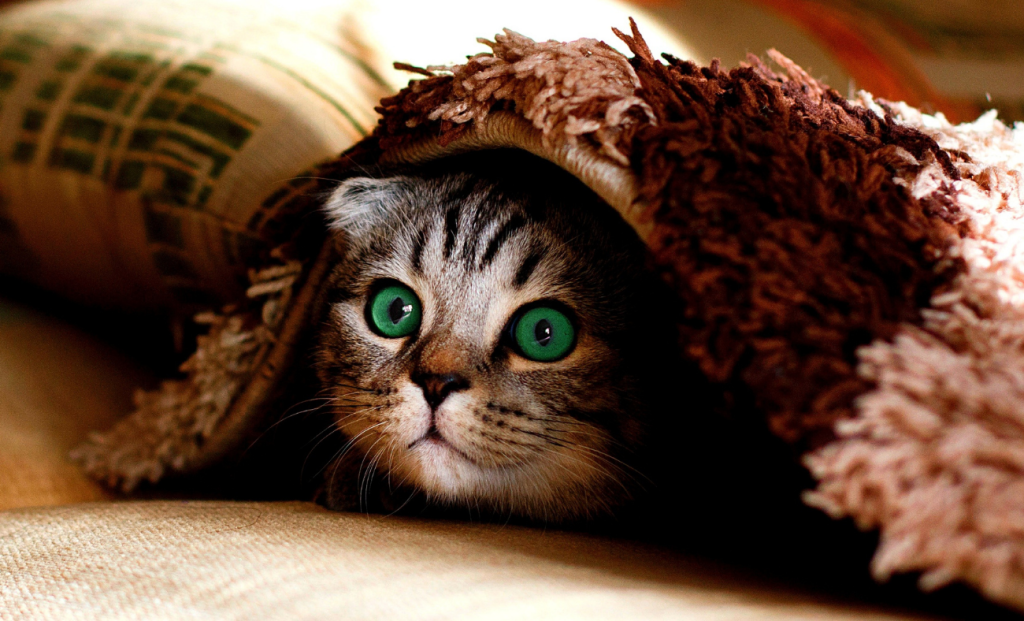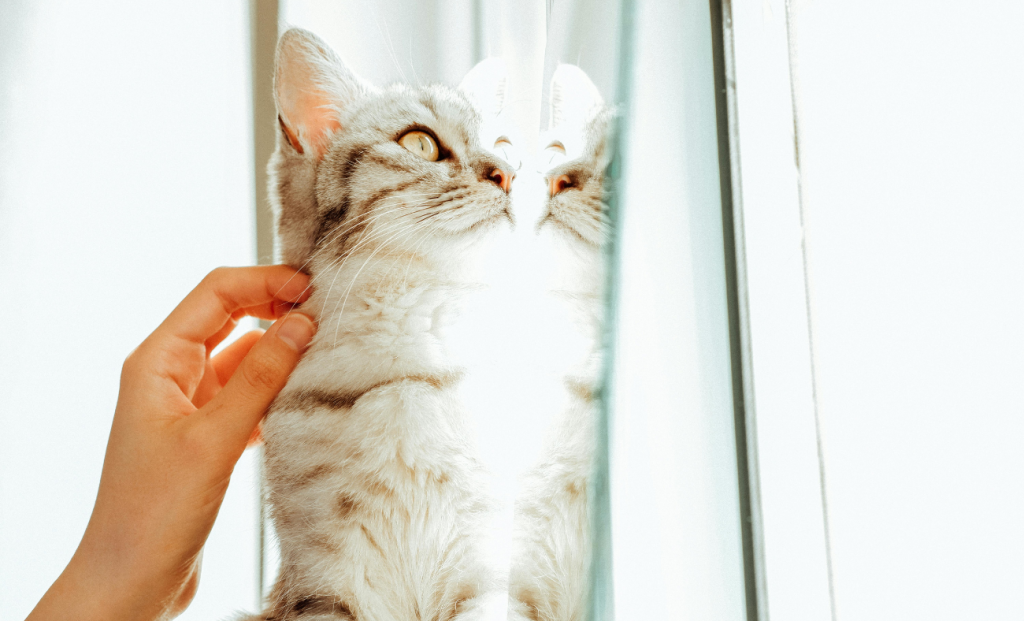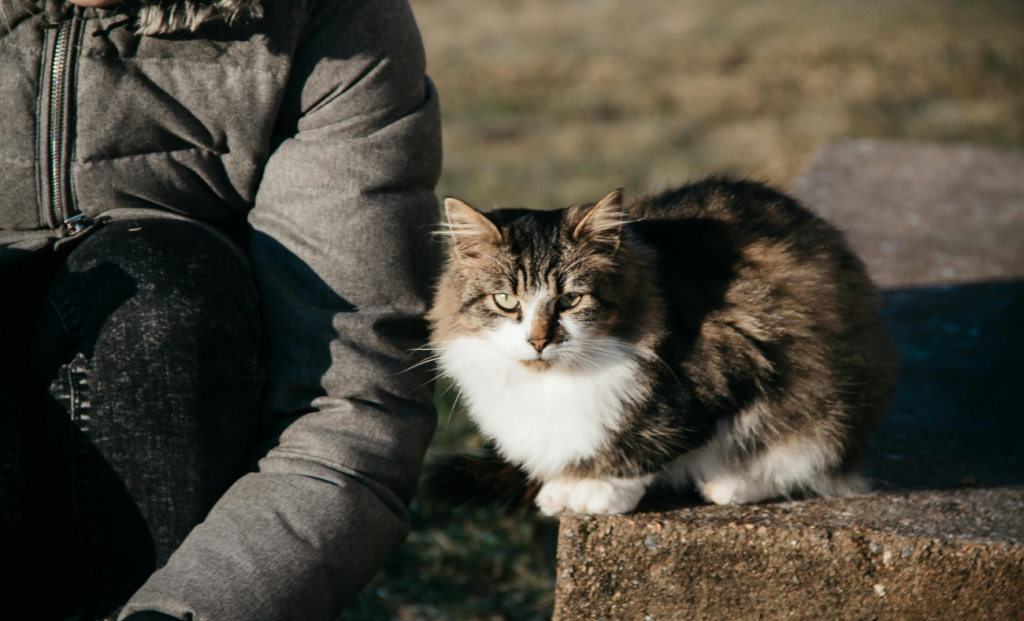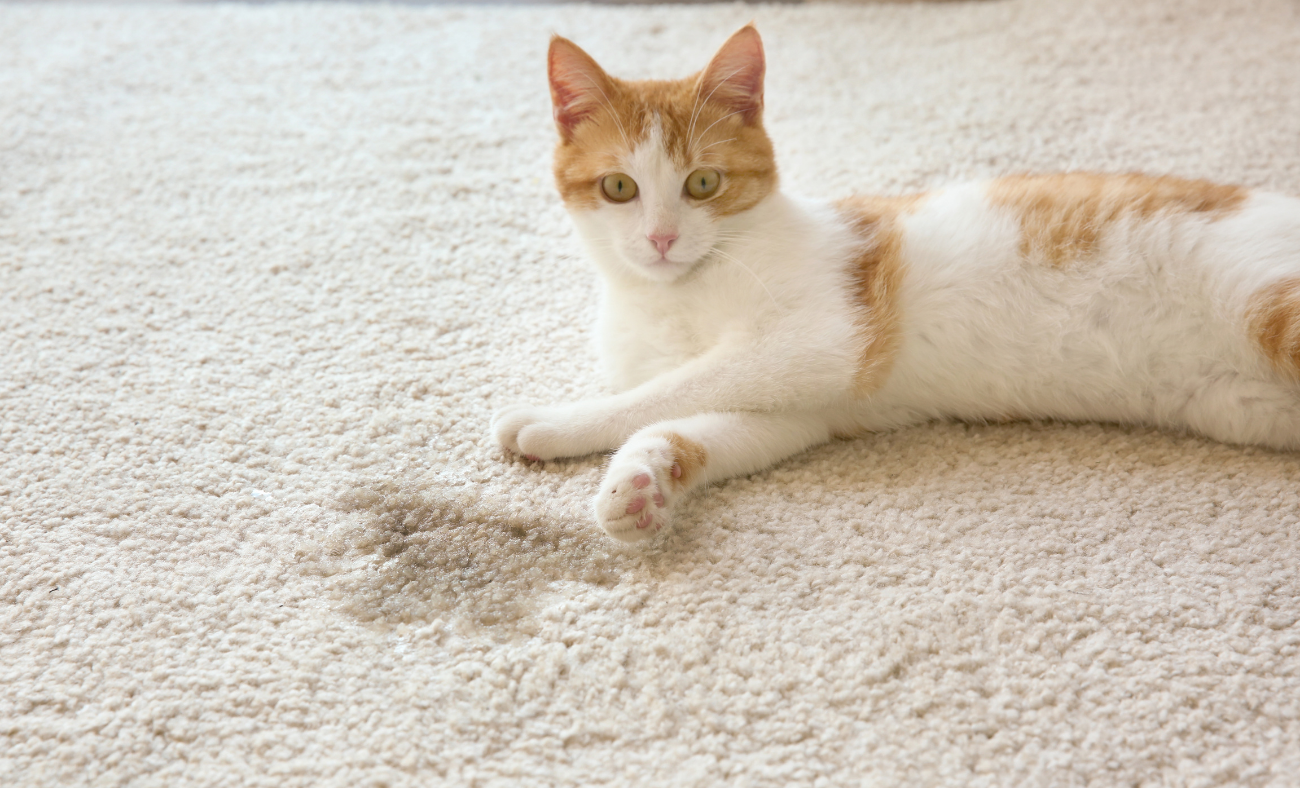That sinking feeling when your usually affectionate cat starts sitting just out of reach, watching you with guarded eyes instead of seeking your touch.
I remember the first time I noticed this behavior in one of the rescue cats I cared for as a child. She would position herself exactly three feet away from where I sat doing homework — close enough to be near me, but far enough that any movement on my part would require deliberate effort to reach her. At ten years old, I didn’t understand what I was witnessing. Now, through my studies into Understanding Feline Anxiety and years of systematic observation, I recognize this as one of the most subtle yet telling stress indicators in cats: The Social Distance Calculator.
This behavioral pattern represents a cat’s sophisticated emotional response to feeling simultaneously drawn to their human companion while needing to maintain protective distance due to underlying cat anxiety. Unlike complete withdrawal or obvious avoidance, the Social Distance Calculator demonstrates a cat’s internal conflict between their attachment needs and their stress responses.
The Invisible Barrier: How Cats Create Emotional Safety Zones
Cat stress and anxiety rarely manifest as dramatic rejection of human contact. Instead, stressed cats often develop what I call “calculated proximity” — a precise emotional and physical distance that allows them to maintain connection while protecting themselves from perceived vulnerability.
When I was caring for the mother cat and her kittens I’d rescued as a child, I learned to recognize these subtle boundaries. The mother would sit close enough to monitor my interactions with her babies but maintained just enough distance to bolt if needed. She was present but not engaged, watchful but not welcoming. This early experience taught me that signs of stress and anxiety in cats often appear as modifications to normal social behavior rather than complete behavioral changes.
The Social Distance Calculator emerges when cats experience internal conflict between their natural social needs and their stress responses. Through my understanding of feline anxiety, I’ve learned that cats are far more social than many people realize, but their social expressions become carefully controlled when they’re managing underlying anxiety. This anxious cat behavior represents sophisticated emotional regulation rather than simple independence.
Recognizing the Calculated Distance Pattern
Anxious cat behavior through the Social Distance Calculator manifests in remarkably consistent patterns. Patterns that cat parents often misinterpret as independence or natural feline aloofness. These cats haven’t stopped caring about their humans. They’ve started protecting themselves while maintaining connection.
The most telling sign? Positional precision. A cat displaying this stress indicator will consistently position themselves at a specific distance from their humans — close enough to observe and participate peripherally, but far enough to maintain escape routes and avoid direct interaction pressure. This distance often remains remarkably consistent across different rooms and situations. It suggests deliberate emotional calculation rather than coincidental positioning.
I witnessed this pattern firsthand when my own cat developed stress-induced cystitis. During her recovery, she would sit precisely at the edge of our living room while we watched television. Present for family activities. But maintaining her measured distance. She wanted to be part of our evening routine, but her anxiety made closer interaction feel too vulnerable. This type of anxious cat behavior demonstrates the complex emotional calculations these cats make to balance their social needs with their stress management requirements.
The Language of Guarded Affection
Cat hiding behavior often gets the most attention as a stress indicator. But the Social Distance Calculator represents something more complex. A cat who wants to maintain connection but needs to control the terms. These cats develop sophisticated ways to show affection while maintaining their protective boundaries.
Eye contact becomes carefully modulated in this form of cat anxiety. Instead of the slow blinks and direct gaze of a relaxed cat, Social Distance Calculator cats offer brief glances followed by deliberate looking away. They’re communicating awareness and connection, while avoiding the vulnerability that extended eye contact represents for an anxious cat.
Purring patterns change significantly. Rather than the spontaneous, loud purring of a content cat seeking interaction, these cats may purr quietly when humans aren’t looking directly at them, or offer brief purr sessions that stop immediately when humans move toward them. The purring communicates their positive feelings. The controlled duration maintains their emotional safety.
The most heartbreaking aspect of this pattern? How these cats often show increased interest in their humans’ belongings while maintaining distance from the humans themselves. They may sleep on clothing, sit on recently vacated chairs, or choose spots that carry their human’s scent. Seeking connection through proxy while avoiding direct interaction that feels too overwhelming. This anxious cat behavior reflects their deep attachment coupled with their need for emotional protection.

Environmental Triggers That Amplify Distance Needs
Through my systematic observation of cat stress patterns, I’ve identified specific environmental factors that intensify the Social Distance Calculator behavior. Cat stress relief requires understanding these triggers and addressing them systematically rather than trying to force closer interaction.
Household activity levels significantly impact distance calculations. During busy periods with multiple family members moving through spaces, stressed cats often increase their calculated distance to account for unpredictable movement and noise. I learned this when helping my kitten through grief after losing his sibling. He needed extra space during active family times but could tolerate closer proximity during quiet evening hours. This anxious cat behavior demonstrates how environmental unpredictability directly influences emotional safety needs.
Changes in household routines create particular challenges for Social Distance Calculator cats. These cats rely on predictable patterns to feel secure enough to maintain their careful proximity. When routines shift unexpectedly, they often increase their protective distance until new patterns feel safe and predictable.
Multi-person households present complex calculations for these anxious cats. They may maintain different distances with different family members based on each person’s behavior patterns, energy levels, and historical interactions. Understanding these individual variations helps families support their cat’s emotional needs more effectively.
The Difference Between Independence and Anxiety
Many cat parents mistake Social Distance Calculator behavior for normal feline independence. They miss the underlying cat anxiety that drives this pattern. Understanding the distinction is crucial for providing appropriate support and intervention.
Independent cats choose proximity based on their immediate preferences and comfort levels. They may sit close one moment and move away the next based on temperature, noise, or simple mood changes. Their body language remains relaxed. Their movements are fluid. Their distance choices appear random rather than calculated.
Social Distance Calculator cats are different. Completely different. They demonstrate consistent measurement in their positioning. Their body language shows subtle tension even while resting. Their movements have a quality of deliberate placement. Their distance choices follow predictable patterns that suggest internal anxiety management rather than simple preference. This anxious cat behavior maintains remarkable consistency. Consistency that reveals its emotional protective function.
The key difference lies in flexibility. Independent cats easily adjust their proximity based on circumstances and invitations. Anxious cats maintain their calculated distance even when circumstances suggest closer interaction would be comfortable and welcome. Recognizing this distinction helps cat parents understand when their cat needs systematic anxiety support rather than simply respecting normal independence preferences.

How Touch Avoidance Develops Gradually
Anxiety in cats demonstrated by the Social Distance Calculator often develops so gradually that families don’t notice the progression until the distance has become significant. What begins as slightly reduced physical contact can evolve into systematic touch avoidance that maintains emotional connection while eliminating physical vulnerability.
Early stages often involve subtle changes in how cats position themselves for petting. Instead of fully settling into laps or lying against human bodies, these cats may sit just close enough for gentle head scratches but position themselves for quick movement if needed. They’re seeking the comfort of touch while maintaining control over the interaction. This early anxious cat behavior signals developing stress before more obvious indicators appear.
As anxiety increases, cats may begin accepting touch only on their terms. Approaching humans briefly for specific types of contact, then moving back to their calculated distance. These interactions become increasingly brief and controlled, with cats managing both the initiation and termination of physical contact.
Advanced Social Distance Calculator behavior involves cats who observe family activities intently but avoid all direct physical contact. These cats still show clear attachment and interest but have determined that physical interaction creates too much anxiety. Understanding this progression helps families recognize when anxious cat behavior is developing and intervene before the need to maintain distance becomes entrenched.
The Role of Past Trauma in Distance Calculation
My childhood experience with rescued cats taught me that Social Distance Calculator behavior often develops from past experiences. This occurs when close contact feels unsafe or unpredictable. Cats who have experienced trauma — whether from human handling, veterinary procedures, or environmental stressors — may develop distance needs as a protective mechanism.
Unlike cats who completely withdraw from human contact, Social Distance Calculator cats demonstrate resilience by finding ways to maintain relationships while protecting their emotional wellbeing. This behavior represents adaptation rather than rejection, though it requires understanding and patience from their human families.
Recovery from trauma-related Social Distance Calculator behavior requires consistent, patient respect for the cat’s boundaries while creating opportunities for positive interactions at their calculated distance. Forcing closer contact typically increases anxiety and extends the recovery period.
Creating Safety Within Distance
Cat stress relief for Social Distance Calculator cats focuses on making their chosen distance feel safer and more rewarding rather than trying to eliminate the distance itself. This approach respects the cat’s emotional needs while gradually building confidence that closer interaction can be safe.
Environmental modifications can significantly support these cats. Creating comfortable spots at their preferred distance — with soft bedding, elevated perches, or cozy hiding options — acknowledges their needs while providing comfort. These spaces become safe observation points that honor their proximity needs while maintaining connection.
Interactive play becomes particularly valuable for Social Distance Calculator cats because it provides positive interaction that respects their distance requirements. Wand toys, laser pointers, and puzzle feeders allow cats to engage actively with their humans while maintaining their emotional safety zone.
Food-based positive associations work exceptionally well at appropriate distances. Offering special treats, meals, or puzzle feeders at the cat’s preferred proximity helps build positive associations with human presence without violating their space needs. Over time, these positive experiences may naturally reduce the required distance as anxiety decreases.
Respecting Boundaries While Building Trust
The most common mistake I see families make with Social Distance Calculator cats is attempting to override the distance through persistence, treats, or forced interaction. This approach typically increases anxiety and can extend the time needed for natural trust rebuilding.
Successful intervention requires becoming predictable and non-threatening at the cat’s chosen distance. This means moving slowly, speaking softly, and avoiding sudden movements that might trigger increased distance needs. Consistency in behavior helps anxious cats feel safer maintaining their proximity without constant vigilance. When families understand that this anxious cat behavior serves an important emotional function, they can work with it rather than against it.
Reading subtle body language cues becomes essential for supporting these cats effectively. Learning to recognize when a cat is comfortable at their distance versus when they need additional space helps families provide appropriate support without accidentally increasing stress. Signs of relaxation at distance — such as slow blinking, gentle purring, or relaxed body posture — indicate that the cat feels safe in their calculated proximity.
When Distance Needs Signal Deeper Issues
While the Social Distance Calculator represents adaptive behavior for managing anxiety, persistent or increasing distance needs may indicate underlying issues requiring professional attention. Cat anxiety symptoms that worsen over time or interfere significantly with the cat’s quality of life warrant veterinary evaluation.
Medical issues can contribute to distance needs, particularly conditions that cause pain or discomfort with handling. Arthritis, dental problems, or skin sensitivities may make cats avoid contact while still wanting to maintain social connection. Ruling out physical causes ensures that behavioral interventions address the actual underlying issues.
Some cats develop Social Distance Calculator behavior in response to environmental stressors that require systematic identification and modification. Multi-cat household dynamics, noise issues, or routine disruptions may create ongoing anxiety that manifests as increased distance needs. Addressing these environmental factors often reduces the calculated distance naturally.
Building Confidence Through Systematic Support
Cat stress and anxiety management for Social Distance Calculator cats requires patience, consistency, and respect for their emotional processing timeline. Recovery involves gradual confidence building rather than dramatic behavioral changes.
Creating multiple positive interaction opportunities at appropriate distances helps cats associate human presence with good experiences without feeling pressured. These might include gentle talking, slow blinking, or simply sitting quietly while the cat observes from their safe space.
Some cats benefit from having control over interaction initiation. Allowing them to approach for brief contact on their terms, then respecting their retreat to preferred distance, helps build trust while honoring their emotional needs. Over time, these self-initiated interactions often become longer and more frequent.
Environmental enrichment that doesn’t require close human interaction can help reduce overall anxiety levels, which may naturally decrease distance needs. Puzzle feeders, window perches, and interactive toys provide mental stimulation and positive experiences that support general emotional wellbeing.

The Journey from Distance to Connection
Recovery timelines for Social Distance Calculator cats vary significantly based on the underlying causes of their anxiety, their individual personalities, and the consistency of their support systems. Some cats show gradual distance reduction within weeks, while others may maintain calculated proximity for months while building confidence.
Success often appears as subtle changes in body language at the chosen distance rather than dramatic reductions in space needs. Cats may begin showing more relaxed postures, increased purring at distance, or more frequent voluntary eye contact before they feel ready for closer physical proximity.
The ultimate goal isn’t necessarily eliminating all distance needs but helping cats feel genuinely comfortable and secure in their social relationships. Some cats may always prefer a degree of space while enjoying rich, rewarding relationships with their humans within those boundaries.
Understanding and respecting the Social Distance Calculator behavior creates foundation for trust, patience, and genuine connection that honors both feline emotional needs and human desires for companionship. When we recognize this behavior as sophisticated emotional management rather than rejection, we can provide the systematic support that helps anxious cats feel truly secure in their relationships.
Your cat’s calculated distance isn’t about loving you less — it’s about loving you while protecting their emotional wellbeing. That delicate balance deserves our understanding, respect, and patient support as they navigate their path back to feeling genuinely secure in closeness.When cat anxiety creates Social Distance Calculator behavior, systematic assessment and intervention can help identify the specific stressors that make closer connection feel unsafe. If you’re ready to understand your cat’s unique emotional needs and support their journey toward greater confidence, download our Cat Stress Assessment Checklist: The Essential 12 Hidden Signals to systematically evaluate the factors that may be influencing your cat’s social comfort levels and develop a personalized plan for building their emotional security.


